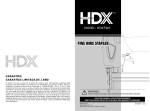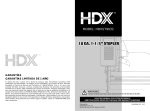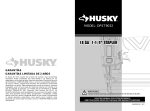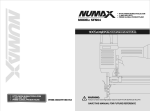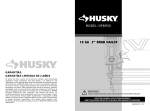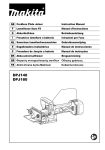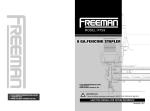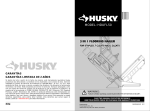Download Husky HDPMPN Use and Care Manual
Transcript
MODEL: DPHMPN WARNING: Failure to follow warnings could result in DEATH OR SERIOUS INJURY. SAVE THIS MANUAL FOR FUTURE REFERENCE Distributed By: Home Depot U.S.A., Inc. KEEP YOUR DATED PROOF OF PURCHASE FOR WARRANTY PURPOSES 2455 Paces Ferry Rd, N.W. Atlanta, GA 30339 IMH400900AV-E/S 06/12 GENERAL SAFETY RULES UNPACKING FEATURES OPERATION LUBRICATION DRIVING A FASTENER SETTING THE AIR PRESSURE MAINTENANCE RECOMMENDED HOOKUP TROUBLE SHOOTING WARRANTIES P2 P6 P7 P7 P8 P8 P8 P9 P9 P10 Risk to hearing: Always wear ear protection when using this tool. Failure to do so may result in hearing loss. WARNING: The warnings and precautions discussed in the manual cannot cover all possible conditions and situations that may occur. It must be understood by the user that common sense and caution are factors which cannot be built into this product, but must be supplied by the user. SAVE THIS MANUAL Keep this manual for the safety warnings, precautions, operations, inspections and maintenance. Keep this manual and the receipt in a safe and dry place for future reference. ! WARNING: To avoid serious personal injury, do not attempt to use this product until you read the manual thoroughly and understand it completely. Save this manual and review frequently for continuing safe operation and instructing others who may use this tool. SYMBOLS Some of the following symbols may be used on this tool. Please study them and learn their meaning. Proper interpretation of these symbols will allow you to operate the tool better and safer. Read operator's manual : To reduce the risk of injury, user must read and understand operator's manual before using this product. 01 SIGNAL MEANING Eye protection: Always wear safety goggles, safety glasses with side shields, or a full face shield when operating this product. ! WARNING: Indicates a potentially hazardous situation, which, if not avoided, could result in death or serious injury. Risk of serious personal injury: Never place hands or any other body parts in the fastener discharge area of the nailer. The tool might eject a fastener and could result in death or serious personal injury. ! CAUTION: Indicates a potentially hazardous situation, which, if not avoided, may result in minor or moderate injury. CAUTION: (Without symbol) Indicates a situation that may result in property damage. In this manual, on the labels, packages and all other information provided with this tool. The following signal words and meanings are intended to explain the levels of risk associated with this tool. GENERAL SAFETY RULES IMPORTANT SAFETY INSTRUCTIONS INSTRUCTIONS PERTAINING TO A RISK OF FIRE, ELECTRIC SHOCK, OR INJURY TO PERSONS: To reduce the risks of electric shock, fire, and injury to persons, read all the instructions before using the tool. SYMBOLS WDH100401AV-S ! WARNING: When using tools, basic precautions should always be followed, including the following. 10/10 ! WARNING: This product or its power cord may contain chemicals known to the State of California to cause cancer and birth defects or other reproductive harm. Wash hands after handling. CALIFORNIA PROPOSITION 65 02 WORK AREA Keep the work area clean and well lighted. Cluttered benches and dark areas increase the risks of accidents. Do not operate the tool in explosive atmospheres, such as in the presence of flammable liquids, gases, or dust. The tool creates a spark which may ignite flammable liquids, gases or dust. Keep bystanders, children, and others away while operating the tool. Distractions could result in improper use and cause injury. Avoid unintentional misfires. Always use caution to avoid accidentally firing. Do not point towards yourself or anyone whether it contains fasteners or not. PERSONAL SAFETY Do not nail on top of another nail. This is able to cause the nail to be deflected and hit someone, or cause the tool to react and result in a risk of injury to persons. Remove finger from the trigger when not driving fasteners. Never carry the tool with finger on trigger, the tool is able to fire a fastener. Always wear eye protection. Operator and others in the work area should always wear ANSI-approved safety goggles with side shields. Eye protection is used to guard against flying fasteners and debris, which may cause severe eye injury. You can use the goggles packed with the tool. Always wear hearing protection when using the tool. Prolonged exposure to high intensity noise may cause hearing loss. Use safety equipment. A dust mask, non-skid safety shoes and a hard hat must be used for the applicable conditions. Wear a full face shield if you are producing metal filings or wood chips. 03 Dress properly. Do not wear loose clothing or jewelry. Contain long hair. Keep your hair, clothing, and gloves away from moving parts. Loose clothes, jewelry, or long hair can be caught in moving parts. Stay alert, watch what you are doing and use common sense when operating a power tool. Do not use tool while tired or under the influence of drugs, alcohol, or medication. A moment of inattention while operating the tool may cause serious injury. Avoid unintentional firing. Keep fingers away from trigger when not driving fasteners, especially when connecting the tool to the air supply. Do not use on a ladder or unstable supports. Stable footing on a solid surface enables better control of the tool in unexpected situations. Make sure the hose is free of obstructions or snags. Entangled or snarled hoses can cause loss of balance or footing and may become damaged, resulting in possible injury. Do not overreach. Keep proper footing and balance at all times. Proper footing and balance enables better control of the tool in unexpected situations. Do not attach the hose or tool to your body. Attach the hose to the structure to reduce the risk of loss of balance if the hose shifts. Always assume that the tool contains fasteners. Do not point the tool toward yourself or anyone whether it contains fasteners or not. Wash hands after handling. This product or its power cord may contain chemicals known to the State of California to cause cancer and birth defects or other reproductive harm. TOOL USE AND CARE Know this tool. Read manual carefully, learn its applications and limitations, as well as the specific potential hazards related to this tool. Know this tool. Read manual carefully, learn its applications and limitations, as well as the specific potential hazards related to this tool. Use only fasteners that are recommended for your models. Do not use the wrong fasteners or load the fasteners incorrectly. Check for misalignment or binding of moving parts, breakage of parts, and any other condition that may affect the tool's operation. If damaged, have the tool serviced before using. Many accidents are caused by poorly maintained tools. Maintain tools with care. Keep tool clean. A properly maintained tool, reduces the risk of binding and is easier to control. Store tools out of the reach of children and other untrained people. Tools are dangerous in the hands of untrained users. Check operation of the tool before use. Do not use the tool if the workpiece contact mechanism is not working correctly as accidental driving of a fastener may occur. Do not use tool if trigger does not actuate properly. Any tool that cannot be controlled with the trigger is dangerous and must be repaired. Do not force tool. Use the correct tool for your application. The correct tool will do the job better and safer at the rate for which it is designed. Use clamps or another practical way to secure and support the workpiece to a stable platform. Holding a tool by hand or against the body is unstable and may lead to loss of control. Keep the tool and its handle dry, clean and free from oil and grease. Always use a clean cloth when cleaning. Never use brake fluids, gasoline, petroleum-based products, or any strong solvents to clean your tool. Do not use the tool as a hammer. Never use this tool in a manner that could cause a fastener to be directed toward anything other than the workpiece. Never use gasoline or other flammable liquids to clean the tool. Never use the tool in the presence of flammable liquids or gases. Vapors could ignite by a spark and cause an explosion which will result in death or serious personal injury. Do not remove, tamper with, or otherwise cause the trigger lock or trigger to become inoperable. Do not operate any tool which has been modified in a like fashion. Death or serious personal injury could result. Do not touch the trigger unless driving fasteners. Never attach air line to tool or carry tool while touching the trigger. The tool could eject a fastener which will result in death or serious personal injury. Also actuate the trigger lock to the safe position when not in use. Always fit tool with a fitting or hose coupling on or near the tool in such a manner that all compressed air in the tool is discharged at the time the fitting or hose coupling is disconnected. Do not use a check valve or any other fitting which allows air to remain in the tool. Death or serious personal injury could occur. Never place hands or any other body parts in the fastener discharge area of the tool. The tool might eject a fastener and could result in death or serious personal injury. Never carry the tool by the air hose or pull the hose to move the tool or a compressor. Keep hoses away from heat, oil and sharp edges. Replace any hose that is damaged, weak or worn. Personal injury or tool damage could occur. Always assume the tool contains fasteners. Respect the tool as a working implement; no horseplay. Always keep others at a safe distance from the work area in case of accidental discharge of fasteners. Do not point the tool toward yourself or anyone whether it contains fasteners or not. Accidental triggering of the tool could result in death or serious personal injury. 04 Do not drop or throw the tool. Dropping or throwing the tool can result in damage that will make the tool unusable or unsafe. If the tool has been dropped or thrown, examine the tool closely for bent, cracked or broken parts and air leaks. STOP and repair before using, or serious injury could occur. Avoid using the tool when the magazine is empty. Accelerated wear on the tool may occur. Clean and check all air supply hoses and fittings before connecting the tool to an air supply. Replace any damaged or worn hoses or fittings. Tool performance or durability may be reduced. Do not use the tool if it leaks air or does not function properly. Do not operate the tool if it does not contain a legible warning label. Always carry the tool by the handle. Never carry the tool by the air hose. TOOL SERVICE Use only accessories that are identified by the manufacturer for the specific tool model. Use of unauthorized parts or failure to follow maintenance instructions may create a risk of injury. Use only the lubricants supplied with the tool or specified by the manufacturer. Tool service must be performed only by qualified repair personnel. OPERATION Do not drive fasteners near edge of material. The workpiece may split causing the fastener or ricochet, injuring you or people around. 05 Do not drive fasteners near edge of material. The workpiece may split causing the fastener or ricochet, injuring you or people around. Do not carry the tool from place to place holding the trigger. Accidental discharge could result. Choice of triggering method is important. Check manual for triggering options. During normal use the tool will recoil immediately after driving a fastener. This is a normal function of the tool. Do not attempt to prevent the recoil by holding the tool against the work. Restriction to the recoil can result in a second fastener being driven from the tool. Grip the handle firmly and let the tool do the work. Failure to heed this warning can result in serious personal injury. Do not drive fasteners on top of other fasteners or with the tool at an overly steep angle as this may cause deflection of fasteners which could cause injury. Do not actuate the tool unless you intend to drive a fastener into the workpiece. Always handle the tool with care: ◆Respect the tool as a working implement. ◆Never engage in horseplay. ◆Never pull the trigger unless nose is directed toward the work. ◆Keep others a safe distance from the tool while tool is in operation as accidental actuation may occur, possibly causing injury. AIR SUPPLY AND CONNECTIONS The connector on the tool must not hold pressure when air supply is disconnected. If an incorrect fitting is used, the tool can remain charged with air after disconnecting and thus will be able to drive a fastener even after the air line is disconnected, possibly causing injury. Do not use any type of reactive gases, including, but not limited to, oxygen and combustible gases, as a power source. Use filtered, lubricated, regulated compressed air only. Use of a reactive gas instead of compressed air may cause the tool to explode which will cause death or serious personal injury. Use only a pressure-regulated compressed air source to limit the air pressure supplied to the tool. The regulated pressure must not exceed 100 psi. If the regulator fails, the pressure delivered to the tool must not exceed 200 psi. Over pressurizing the tool is able to result in bursting, abnormal operation, breakage of the tool or serious injury to persons. Use only clean, dry, regulated compressed air at the rated pressure or within the rated pressure range as marked on the tool. Always verify prior to using the tool that the air source has been adjusted to the rated air pressure or within the rated air-pressure range. Always disconnect air resource: ◆Before unloading or making adjustments. ◆When maintaining the tool. ◆When clearing a jam. ◆ When touching the safety yoke. ◆When tool is not in use. ◆When moving to a different work area. Such precautionary measures reduce the risk of injury to persons. SAVE THESE INSTRUCTIONS LOADING TOOL Do not load the tool with fasteners when any one of the operating controls is activated. Never place a hand or any part of body in fastener discharge area of tool. Never point tool at anyone. Do not pull the trigger or depress the workpiece contact as accidental actuation may occur, possibly causing injury. ! WARNING: The warnings and precautions discussed above cannot cover all possible conditions and situations that may occur. It must be understood by the user that common sense and caution are factors which cannot be built into this product, but must be supplied by the user. UNPACKING This tool has been shipped completely assembled. Make sure that all items listed in the packing list are included. Carefully remove the tool and any accessories from the box. Inspect the tool carefully to make sure no breakage or damage occurred during shipping. Do not discard the packing material until you have carefully inspected and satisfactorily operated the tool. If any parts are damaged or missing, please call 1-866-676-8468. ! WARNING: If any parts are missing do not operate this tool until the missing parts are replaced. Failure to do so could result in possible serious personal injury. ! WARNING: Do not attempt to modify this tool or create accessories not recommended for use with this tool. Any such alteration or modification is misuse and could result in hazardous condition leading to possible serious personal injury. 06 FEATURES Max.: 0.346” ( 8.8mm) SPECIFICATIONS AIR INLET: 1/4 inch NPT WEIGHT: 1.38 lb MAXIMUM PRESSURE: 100 psi PRESSURE RANGE: 80 psi – 100 psi PIN SIZE RANGE: 2 inch to 4 inch 2” 50mm 4” 100mm 2. Turn the tool so the air inlet is facing up. Place 4-5 drops of pneumatic fastening tool oil into air inlet. Do not use detergent oils, oil additives, or air -tool oils. Do not use detergent oil or additives as these lubricants will cause accelerated wear to the seals and bumpers in the tool, resulting in poor tool performance and frequent tool maintenance. DRIVING A FASTENER 5. Push gently against nail head to drive fastener. ⒈ Connect the air supply to the tool. 3. Hold tool with nose pointed toward work surface. 2. Load fastener into the palm. 4. Align fastener and tool in the location where fastener is to be driven. 0.113”- 0.192” ( 2.87 - 4.87mm) 6. Continue to apply pressure until fastener is driven completely or until reaching desired penetration. OPERATION LUBRICATION This tool requires lubrications before using the tool for the first time and before each use. If an inline oiler is used, manual lubrication through the air inlet is not required on a daily basis. 3. After adding oil, run too briefly. Wipe off any excess oil from the cap exhaust. CAUTION: ⒈Disconnect the air supply from the tool to add lubricant. 07 The work surface can become damaged by excessive lubrication. Proper lubrication is the owner's responsibility. Failure to lubricate the tool properly will dramatically shorten the life of the tool and void your warranty. SETTING THE AIR PRESSURE The amount of air pressure required depends on the size of the fasteners and the workpiece material. Begin testing the depth of drive by driving a test nail into the same type of workpiece material used for the actual job. Drive a test fastener with the air pressure set at 9095psi. Raise or lower the air pressure to find the lowest setting that will perform the job with consistent results. It may be possible to achieve the desired depth with air pressure adjustments alone. MAINTENANCE ! WARNING: Any time inspection, maintenance, and cleaning are done: ◆Disconnect the tool from the air resource. ◆ Empty the magazine completely. 08 ANTI-DUST Each tool is packed with an anti-dust cap on the air connector,check it after unpacking. Keep the anti-dust cap cover the air connector when the tool is not in use. CLEANING Avoid using solvents when cleaning plastic parts. Most plastics are susceptible to damage from various types of commercial solvents and maybe damaged by their use. Use clean cloths to remove dirt, dust , oil, grease, etc. COLD WEATHER OPERATION For cold weather operation, near and below freezing, the moisture in the air line may freeze and prevent tool operation. We recommend the use of air tool lubricant or permanent antifreeze (ethylene glycol) as a cold weather lubricant. 09 ! WARNING: Do not at any time let brake fluids, gasoline, petroleum-based products, penetration oils, ect., come in contact with plastic parts. Chemicals can damage, weaken or destroy plastic which may result in serious personal injury. CAUTION: Do not store tools in a cold weather environment to prevent frost or ice formation on the tool's operating valves and mechanisms that could cause tool failure. RECOMMENDED HOOKUP 1. The air compressor must be able to maintain a minimum of 80 psi when the tool is being used. An inadequate air supply can cause a loss of power and inconsistent driving. 2. An oiler can be used to provide oil circulation through the tool. A filter can be used to remove liquid and solid impurities which can rust or gum up internal parts of the tool. 3. Always use air supply hoses with a minimum working pressure rating equal to or greater than the pressure from the power source if a regulator fails, or 150 psi, whichever is greater. Use 3/8" air hose for runs up to 50'. Use 1/2" air hoses for 50' run or longer. For better performance, install a 3/8" quick plug (1/4" NPT thread) with an inside diameter of .315" (8mm) on the tool and 3/8" quick coupler on the air hose. 4. Use a pressure regulator on the compressor, with an operating pressure of 0-125 psi. A pressure regulator is required to control the operating pressure of the tool between 80 and 100 psi. TROUBLE SHOOTING ! WARNING: Stop using tool immediately if any of the following problems occur. Serious personal injury could result. Any repairs or replacements must be done by a qualified service person or an Authorized service center. CAUTION: The air compressor must be able to maintain a minimum of 80psi when the tool is being used. An inadequate air supply can cause a loss of power and inconsistent driving. ! WARNING: Do not connect with an air compressor which can potentially exceed 200psi. As tool may burst, possibly causing injury. Quick coupler Quick Air hose connector Quick connector PROBLEMS Air leaking between housing and cap Oiler Filter Quick Regulator connector POSSIBLE CAUSE(S) Compressor CORRECTIVE ACTION 1. Loose screws in housing. 2. Damage to cap gasket. 1. Tighten screws. 2. Replace cap gasket. Air leaking through cap exhaust or nose area 1. Air escaping from tool. 2. Damaged O-Ring 1. Slap the cap side of the tool into the palm of your hand with enough force to reset the internal piston. 2. Replace O-rings. Nailer not setting fastener completely 1. Nail guide loose. 2. Inadequate air flow to nailer 1. Tighten nose guide. 2. Check hose, fitting, or compressor. Nailer operates slowly or has loss of power 1. Nailer not lubricated sufficiently. 2. Worn O-rings. 3. Low air pressure. 1. Lubricate nailer. 2. Replace and lubricate O-rings. 3. Check and adjust pressure. WARRANTY 2 YEARS LIMITED WARRANTY If within two years from the date of purchase, this Husky air tool product fails due to a defect in materials or workmanship, please immediately contact Product Support at 1-866-676-8468 (8am to 5pm EST, M-F, except normal Holiday).Do not return the air tool to the store. Please be prepared to send the product, postage prepaid, along with a copy of the dated first owner purchase receipt with the tool model to: PRIME GLOBAL PRODUCTS, INC. Address: Ball Ground, Ga 30107 . A defective product will be promptly replaced with a new one of equal or greater value. This warranty excludes incidental/consequential damages and failures due to misuse, abuse or normal wear and tear. This warranty gives you specific rights, and you may also have other rights, which vary, from state to state. Please call 1-866-676-8468 for details. 10 MODELO: DPHMPN NORMAS GENERALES DE SEGURIDAD DESEMPACAR CARACTERÍSTICAS OPERACIÓN LUBRICACIÓN COLOCAR UN SUJETADOR CÓMO CONFIGURAR LA PRESIÓN DE AIRE MANTENIMIENTO CONEXIÓN RECOMENDADA SOLUCIÓN DE PROBLEMAS GARANTÍAS ADVERTENCIA: No seguir las advertencias correctamente puede causar LA MUERTE O LESIONES GRAVES. GUARDA ESTE MANUAL PARA CONSULTARLO EN EL FUTURO. GUARDE SU COMPROBANTE DE COMPRA CON FECHA PARA FINES DE LA GARATÍA. Distribuido Por: Home Depot U.S.A., Inc. 2455 Paces Ferry Rd, N.W. Atlanta, GA 30339 P12 P16 P17 P17 P18 P18 P19 P19 P20 P21 ADVERTENC IA: Las advertencias y precauciones mencionadas en este manual no abarcan todas las condiciones y situaciones posibles. Es perfectamente comprensible que no podemos fabricar el sentido común y la precaución como partes de ningún producto, el usuario es el responsable de obrar en consecuencia. GUARDAR ESTE MANUAL Guarda este manual para tener a mano la s a dve rt e nci as d e se gu rida d, precauciones, operaciones, inspecciones y mantenimiento. Guarda este manual y elrecibo en un lugar seguro y seco para consultarlo en el futuro. ! ADVERTENCIA: Para evitar lesiones personales graves, no intentes usar este producto hasta haber leído y comprendido el manual por completo. Guarda este manual y consúltalo con frecuencia para un funcionamiento seguro y para instruir a otros usuarios de esta herramienta. SÍMBOLOS Algunos de los siguientes símbolos pueden ser utilizados en esta herramienta. Por favor, estudiarlos y aprender su significado. Una correcta interpretación de estos símbolos le permitirá utilizar la herramienta mejor y más seguro. Lea el manual del operador de: Para reducir el riesgo de lesiones, el usuario debe leer y entender el manual del operador antes de usar este producto. 11-SP Protección de los ojos: Use siempre gafas de seguridad, gafas de seguridad con protección lateral o una careta completa cuando utilice esta producto. El riesgo a la audición: Siempre use protección para los oídos cuando se utiliza este tool. Failure lo contrario, podría resultar en la pérdida de audición. Riesgo de lesiones personales graves: Nunca coloque las manos o cualquier otra parte del cuerpo en la zona de descarga del sujetador de la clavadora. La herramienta puede expulsar un sujetador y puede causar la muerte o lesiones graves. Símbolos en este manual, las etiquetas, envases y en toda la información provista con esta herramienta. Las siguientes palabras de aviso y significados tienen el objetivo de explicar los niveles de riesgo asociados con esta herramienta. SÍMBOLOS 12-SP AVISO SIGNIFICADO ! ADVERTENCIA: Indica una situación potencialmente peligrosa que, de no evitarse, podría causar la muerte o lesiones graves. ! PRECAUCIÓN: Indica una situación potencialmente peligrosa que, de no evitarse, podría causar la muerte o lesiones graves. PRECAUCIÓN: (Sin símbolo) Indica una situación que puede resultar en daños a la propiedad. NORMAS GENERALES DE SEGURIDAD INSTRUCCIONES DE SEGURIDAD IMPORTANTES Instrucciones en referencia al peligro de incendios, choque electrico o lesiones personales: Para reducir los riesgos de choque eléctrico, incendio y lesiones personales, lea todas las instrucciones antes de usar la herramienta. ! ADVERTENCIA: Cuando se usen herramientas, siempre se deberá n seguir precauciones básicas, incluyendo las siguientes. PROPOSICION 65 DE CALIFORNIA ! ADVERTENCIA: Este producto, a su cordon electrico, puede contener productos quimicos conocidos por el estado de California como causantes de cancer y defectos de nacimiento u otros danos reproductiveos. Lave sus manos despues de usar. AREA DE TRABAJO Mantenga el área de trabajo limpia y bien iluminada. Los bancos de trabajo desordenados y las áreas oscuras aumentan el riesgo de accidentes. No utilice la herramienta en atmósferas en las que exista riesgo de explosión, como por ejemplo en presencia de líquidos inflamables, gases o polvo. La herramienta produce una chispa que podría encender líquidos inflamables, gases o polvo. Mantenga a los transeúntes, niños y a otras personas alejadas cuando esté utilizando la herramienta. Las distracciones podrían resultar en el uso inapropiado y causar lesiones. Evite los disparos accidentales. Siempre tenga precaución para evitar disparos accidentales. No apunte la herramienta hacia usted u otra persona, aun cuando no contenga sujetadores. SEGURIDAD PERSONAL No clave sobre otro clavo. Esto puede causar que el clavo se desvíe y alcance a alguien, o que la herramienta reaccione de alguna manera y lesione a alguien. Retire el dedo del gatillo cuando no coloca sujetadores. Nunca transporte la herramienta con el dedo en el gatillo, ya que la herramienta puede disparar un sujetador. Usa siempre protección para los ojos. El operador y las otras personas en el área de trabajo deben usar siempre gafas de seguridad con protectores laterales, aprobadas por ANSI. La protección de los ojos se utiliza para resguardarlos de los fijadores y residuos que puedan saltar, los cuales pueden causar lesiones graves en los ojos. Puedes usar las gafas que vienen con la herramienta. Usa siempre protección auditiva cuando utilices la herramienta. La exposición prolongada a ruidos de alta intensidad puede causar la pérdida de la audición. Usa un equipo de seguridad. Se deben usar una máscara antipolvo, calzado de seguridad antideslizante y un casco rígido en condiciones donde sean necesarios. Usa una máscara protectora completa si estás trabajando con virutas de madera o limaduras de metales. Usa la vestimenta adecuada. No utilices ropa o joyas sueltas. Recoge el cabello largo. Mantén el cabello, la ropa y los guantes alejados de las partes móviles. La ropa y las joyas sueltas o el cabello largo pueden quedar atrapados en las partes móviles. Cuando utilices una herramienta de motor mantente alerta, observa lo que estás haciendo y utiliza el sentido común. No utilices la herramienta si estás cansado o bajo el efecto de drogas, alcohol o medicamentos. Un momento de distracción durante la operación de la herramienta puede causar lesiones graves. Para evitar disparos accidentales mantenga los dedos alejados del gatillo cuando no accione los sujetadores, especialmente cuando conecte la herramienta al suministro de aire. No la utilices sobre una escalera de tijera o soportes inestables. Una posición estable sobre una superficie sólida permite un mejor control de la herramienta en situaciones imprevistas. Asegúrate de que la manguera esté libre de obstrucciones o trabas. Las mangueras atascadas o enredadas pueden causar la pérdida del equilibrio o la estabilidad y pueden dañarse y causar lesiones. No se extienda demasiado. Mantenga un apoyo de pies y un equilibrio adecuados en todo momento. Un apoyo de pies y equilibrio adecuados permiten un mejor control de la herramienta en situaciones inesperadas. No fije la manguera o herramienta a su cuerpo. Fije la manguera a la estructura para reducir el riesgo de pérdida de equilibrio en caso que la manguera se mueva. Siempre dé por sentado que la herramienta contiene sujetadores. No apunte la herramienta hacia usted u otra persona, aun cuando no contenga sujetadores. Lávese las manos después de manipularlo. Este producto o su cable eléctrico pueden contener sustancias químicas reconocidas por el estado de California como causantes de cáncer, defectos congénitos y otros daños en el aparato reproductivo. USO Y CUIDADO DE LA HERRAMIENTA Infórmate sobre la herramienta. Lee el manual con cuidado, aprende sobre sus aplicaciones y limitaciones, como también sobre los riesgos específicos y potenciales relacionados con la herramienta. Usa únicamente los fijadores recomendados para el modelo. No uses los fijadores incorrectos ni los cargues de forma inadecuada. Comprueba que las piezas móviles no estén desalineadas ni bloqueadas, que no haya piezas dañadas o cualquier otra condición que pueda afectar el funcionamiento de la herramienta. 13-SP Si está dañada, repara la herramienta antes de utilizarla. Muchos accidentes se deben al mantenimiento incorrecto de la herramienta. Cuida la herramienta para mantenerla en buenas condiciones. Mantén limpia la herramienta. Una herramienta con el mantenimiento adecuado corre menos riesgo de bloquearse y es más fácil de controlar. Guarda las herramientas fuera del alcance de los niños y otras personas que no sepan como utilizarlas. Las herramientas son peligrosas en manos de usuarios que no saben como utilizarlas. Comprueba el funcionamiento de la herramienta antes de usarla. No uses la herramienta si el mecanismo de contacto de la pieza de trabajo no funciona correctamente para evitar disparar los fijadores accidentalmente. No utilice la herramienta si el gatillo no se acciona correctamente. Toda herramienta que no pueda controlarse con el gatillo es peligrosa y debe repararse. No fuerces la herramienta. Utiliza la herramienta correcta según la aplicación. La herramienta correcta realizará el trabajo mejor y con más seguridad a la velocidad para la cual está diseñada. Usa abrazaderas u otra forma práctica para asegurar y sujetar la pieza de trabajo a una plataforma estable. Sostener la herramienta con la mano o apoyarla contra el cuerpo no ofrece la estabilidad adecuada y puede causar pérdida de control. Mantén la herramienta y el mango secos, limpios y libres de aceite o grasa. Usa siempre un paño limpio para la limpieza. Nunca uses líquido de freno, gasolina, productos a base de petróleo ni solventes para limpiar la herramienta. No utilices la herramienta como martillo. No utilices esta herramienta de tal manera que los fijadores se dirijan hacia cualquier 14-SP otra cosa que no sea la pieza de trabajo. Nunca utilice gasolina ni ningún otro líquido inflamable para limpiar la herramienta. Nunca utilice la herramienta en presencia de líquidos o gases inflamables. Los vapores podrían encenderse por una chispa y causar una explosión que podría provocar lesiones personales graves o la muerte. No retire, fuerce ni haga que el gatillo o el seguro del mismo queden inutilizables. No haga funcionar ninguna herramienta que se haya modificado de dicha manera, en caso contrario podrían ocurrir lesiones personales graves o la muerte. No apriete el gatillo a menos que coloque sujetadores. Nunca fije el conducto de aire comprimido ni cargue la herramienta mientras aprieta el gatillo. La herramienta podría lanzar un sujetador y provocar lesiones personales graves o la muerte. Siempre coloque el seguro del gatillo en la posición de seguridad cuando no use la herramienta. Siempre fije la manguera con un conector o acoplador de manguera sobre o cerca de la herramienta, de forma tal que todo el aire comprimido en la herramienta se descargue al momento en que el conector o el acoplador de la manguera estén desconectados. No utilice una válvula de control ni ningún otro conector que permita que el aire permanezca en la herramienta, en caso contrario podrían ocurrir lesiones personales graves o la muerte. Nunca coloque las manos ni otra parte del cuerpo en el área de descarga de sujetadores de la herramienta. La herramienta podría lanzar un sujetador y provocar lesiones personales graves o la muerte. Nunca transporte la herramienta de la manguera de aire comprimido ni jale la manguera para mover la herramienta o un compresor. Mantenga las mangueras alejadas del calor, el aceite y los bordes filosos. Reemplace las mangueras dañadas o desgastadas, en caso contrario podrían ocurrir lesiones personales o daños en la herramienta. Siempre dé por sentado que la herramienta contiene sujetadores. Considere la herramienta como un implemento de trabajo y no juegue con ella. Siempre mantenga a las demás personas a una distancia segura del lugar de trabajo, en caso se produzcan descargas accidentales de sujetadores. No apunte la herramienta hacia usted u otra persona, aun cuando no contenga sujetadores. La activación accidental de la herramienta podría provocar lesiones personales graves o la muerte. No deje caer ni lance la herramienta.Ya que esto podría ocasionar daños en la herramienta y causar que la misma ya no sea utilizable o segura. Si la herramienta ha sufrido caídas o ha sido lanzada, examínela atentamente y revise si hay piezas dobladas, rajadas o rotas y si hay fuga de aire comprimido. NO PROSIGA y repárela antes de usarla, en caso contrario podrían ocurrir lesiones graves. Evite usar la herramienta cuando el cargador está vacío. Ya que esto puede producir desgaste acelerado en la herramienta. Limpie y revise todas las mangueras y conectores de suministro de aire comprimido antes de conectar la herramienta a un suministro de aire comprimido. Reemplace las mangueras y conectores dañados o desgastados, de lo contrario el rendimiento o la durabilidad de la herramienta podrían verse reducidos. No utilices la herramienta si pierde aire o no funciona correctamente. No utilices la herramienta si no tiene una etiqueta de advertencia legible. Siempre sujeta la herramienta por el mango. Nunca la sujetes por la manguera de aire. REPARACIÓN DE LA HERRAMIENTA Usa únicamente accesorios identificados por el fabricante para ese modelo específico de herramienta. La utilización de piezas no autorizadas o el incumplimiento de las instrucciones de mantenimiento pueden aumentar el riesgo de lesiones. Usa únicamente los lubricantes provistos con la herramienta o especificados por el fabricante. La reparación de la herramienta debe ser realizada únicamente por personal calificado. FUNCIONAMIENTO No coloques fijadores cerca del borde del material. La pieza de trabajo puede partirse y hacer que el fijador rebote y te dañe a ti o a las personas alrededor. No traslade la herramienta de un lugar a otro presionando el gatillo. Esto podría provocar una descarga accidental. La opción del método de disparos es importante. Verifique el manual para las opciones de disparo. Durante el uso normal la herramienta se rebobinará de inmediato luego de accionar un sujetador. Esta es una función normal de la herramienta. No intente evitar la rebobinación sosteniendo la herramienta en contra del funcionamiento. La restricción para rebobinar puede provocar que se accione un segundo sujetador desde la herramienta. Sujete la manija firmemente y permita que la herramienta realice el trabajo. No seguir esta advertencia puede provocar graves lesiones personales. No coloques fijadores sobre otros fijadores o con la herramienta a un ángulo demasiado inclinado ya que esto puede causar el desvío de los fijadores y provocar lesiones. No uses la herramienta a menos que pretendas colocar un fijador en la pieza de trabajo. Opera siempre la herramienta con cuidado: Respeta la herramienta como implemento de trabajo. Nunca la uses en bromas y juegos. Nunca jale el gatillo a menos que la punta esté orientada directamente hacia el trabajo. 15-SP Mantén a los demás a una distancia segura de la herramienta ya que puede accionarse accidentalmente, y posiblemente causar lesiones. ENTRADA DE AIRE Y CONEXIONES El conector de la herramienta no debe estar bajo presión al desconectar la entrada de aire. Si se utiliza un acoplador incorrecto, la herramienta puede quedar cargada de aire luego de la desconexión y podría disparar fijadores incluso con la línea de aire desconectada y ello puede causar lesiones. No utilice ningún tipo de gases reactivos, lo que incluye pero no se limita al oxígeno o a gases combustibles, como fuente de alimentación. Use únicamente aire comprimido filtrado, lubricado y regulado. El uso de gas reactivo en lugar de aire comprimido puede hacer que la herramienta explote, lo cual produciría lesiones personales graves o la muerte. Use únicamente una fuente de aire comprimido de presión regulada para limitar la presión de aire suministrada a la herramienta. La presión regulada no debe superar los 6,89 Bar. Si el regulador falla, lapresión enviada a la herramienta no debe superar los 13,79 Bar.El exceso de presión de la herramienta es capaz de ocasionar una explosión, funcionamiento anormal, rotura de la herramienta o lesiones graves a personas. Utilice sólo aire limpio y seco, y regulado a la presión nominal o dentro del rango de presión indicado en la herramienta. Verifique siempre antes de utilizar la herramienta que la fuente de aire se ha ajustado a la presión de aire especificada o dentro del rango nominal de presión de aire. Desconecta siempre la fuente de aire: Antes de descargar o realizar ajustes. Al realizar el mantenimiento de la herramienta. Al desatascarla. Al tocar la horquilla de seguridad. Cuando la herramienta no está en uso. Al desplazarse a otra área de trabajo. 16-SP Dichas medidas de precaución reducirán el riesgo de lesiones a personas. EXCEPTO ESTAS INSTRUCCIONES CARGAR LA HERRAMIENTA No cargues la herramienta con fijadores si alguno de los controles operativos está activado. Nunca coloques la mano ni ninguna otra parte del cuerpo en el área de descarga de los fijadores. Nunca apuntes la herramienta hacia las personas. No jale el gatillo ni presione la pieza de trabajo en contacto ya que se podría accionar accidentalmente y posiblemente causar lesiones. ADVERTENCIA: Las advertencias y precauciones mencionadas anteriormente no abarcan todas las condiciones y si t uaci on es posi bl es . Es perfectamente comprensible que no podemos fabricar el sentido común y la precaución como partes de ningún producto, el usuario es el responsable de obrar en consecuencia. DESEMPACAR Esta herramienta se ha enviado completamente ensamblada. Asegúrate de que todos los artículos de la lista de empaque estén incluidos. Retira cuidadosamente la herramienta y los accesorios de la caja. Inspecciona la herramienta cuidadosamente para asegurarte de que no haya ocurrido ninguna rotura ni daño durante el envío. No deseches el material de empaque hasta que hayas inspeccionado cuidadosamente y utilizado satisfactoriamente la herramienta. Si alguna pieza está dañada o falta, llama al 1-866-676-8468 ! ADVERTENCIA: Si falta alguna pieza, no utilices e s t a h e r r a m i e nt a h a s t a reemplazarla. De no seguir esta advertencia, pueden producirse lesiones graves. CARACTERÍSTICAS ESPECIFICACIONES ENTRADA DE AIRE: NPT DE 1/4" PESO DE LA HERRAMIENTA: 0,63 kg PRESIÓN MÁXIMA: 6,89 bar RANGO DE PRESIÓN: 5,52-6,89bar RANGO DE TAMAÑO DEL PASADOR: 50 mm (2”) a 100 mm (4”) OPERACIÓN ! ADVERTENCIA: No intentes modificar esta herramienta o construir accesorios no recomendados para la misma. Tales modificaciones o cambios son considerados un mal uso y pueden resultar en condiciones peligrosas que a su vez pueden posiblemente causar lesiones. La herramienta incluye un sistema de ganchos por separado. Ensamble el gancho en la herramienta antes de usarlo. El gancho se puede colocar tanto del lado izquierdo como derecho. ⒈ Desconecta la herramienta de la fuente de aire, a agregue lubricantes para herramientas. Max.: 0.346” ( 8.8mm) 2” 50mm 4” 100mm 0.113”- 0.192” ( 2.87 - 4.87mm) 2. Gire la herramienta de forma tal que la entrada de aire dé hacia arriba. Coloque 4 a 5 gotas deaceite neumático de la herramienta de la cerradura en la entrada de aire. No utilices aceite detergente ni aditivos puesto que estos Lubricantes causarán el desgaste acelerado de los sellos y amortiguadores de la herramienta, lo que resultará en el mal funcionamiento de la misma y elevará la frecuencia del mantenimiento. LUBRICACIÓN 17-SP 3. Después de agregar el aceite, haga funcionar la herramienta por un breve periodo. Limpie el exceso de aceite de la salida de la cubierta. PRECAUCIÓN: 4. Alinee el sujetador y la herramienta en el lugar en donde colocará el sujetador. La lubricación excesiva puede dañar la superficie de trabajo. Es responsabilidad del propietario lubricar de forma adecuada. El incumplimiento de dicha tarea reducirá significativamente la vida útil de la herramienta y anulará la garantía. 2. Cargue el sujetador en la estructura. ! ADVERTENCIA: 6. Siga aplicando presión hasta colocar por completo el sujetador o hasta alcanzar la profundidad de penetración deseada. CÓMO CONFIGURAR LA PRESIÓN DE AIRE La cantidad de presión de aire requerida depende del tamaño de los fijadores y del material de la pieza de trabajo. Comienza por comprobar la profundidad de clavado disparando un clavo de prueba hacia una pieza de trabajo del mismo material utilizado para el trabajo real. 18-SP Dispara un fijador de prueba con la presión de aire configurada a 6,2-6,6 bar. Aumenta o reduce la presión de aire para hallar la configuración más baja posible para realizar el trabajo con resultados uniformes. Es posible que se pueda lograr la profundidad deseada ajustando únicamente la presión de aire. MANTENIMIENTO 5. Presione suavemente sobre la cabeza del clavo para colocar el sujetador. COLOCAR UN SUJETADOR 1. Conecte la fuente de air a la herramienta . 3. Sujete la herramienta con el extremo dirigido hacia la superficie de trabajo. A ntes de inspeccionar , dar mantenimiento y limpiar: ◆Desconecta la herramienta de la fuente de aire. ◆Vacía el cargador por completo. FUNCIÓN ANTIPOLVO Todas las herramientas vienen con un tapón antipolvo en el conector de aire; verifícalo si lo tienes después de desempacar la herramienta. Mantén el tapón antipolvo para cubrir el conector de aire. LIMPIEZA Evita el uso de solventes para limpiar las piezas plásticas. La mayoría de los plásticos pueden dañarse con facilidad al usar varios tipos de solventes comerciales. Usa paños limpios para limpiar la suciedad, polvo, grasa, etc. ! ADVERTENCIA: En ningún momento dejes que líquidos para freno, gasolina, productos a base de petróleo, aceites penetrantes, etc. entren en contacto con las piezas plásticas. Estos químicos pueden dañar, debilitar o destruir el plástico, lo que puede provocar lesiones graves. OPERACIÓN EN CLIMAS FRÍOS En caso de operación en climas fríos, cerca o debajo del punto de congelamiento, la humedad en la línea de aire puede congelarse evitando el funcionamiento de la herramienta. Recomendamos usar lubricantes para herramientas neumáticas o un anticongelante permanente (glicol de etileno) como lubricante para climas fríos. PRECAUCIÓN: No almacenes la herramienta en un ambiente de clima frío para evitar la formación de escarcha o hielo sobre las válvulas y mecanismos operativos de la herramienta, pues la misma podría dejar de funcionar. CONEXIÓN RECOMENDADA 1. El compresor de aire debe ser capaz de mantener un mínimo de 5,52 bar mientras la herramienta está en uso. Un suministro inadecuado de aire puede causar una pérdida de potencia y un clavado desigual. 2. Se puede usar un lubricador para proporcionar circulación de aceite en toda la herramienta. Se puede usar un filtro para retirar las impurezas líquidas y sólidas, las que pueden oxidar piezas internas de la herramienta o hacer que éstas se apelmacen. 3. Siempre use mangueras de aire comprimido con una clasificación de presión de trabajo igual o superior a la presión de la fuente de alimentación en caso que el regulador falle, o de 10,34 bar, el que sea mayor. Use mangueras de aire comprimido de 3/8" para distancias de hasta 15,24 m. Use mangueras de aire comprimido de ½” para distancias de 15,24 mo superiores. Para obtener un mejor rendimiento, instale un tapón de conexión rápida de 3/8” (rosca NPT de ¼”) con un diámetro 19-SP interior de 0.315” (8 mm) en la herramienta y un acoplador de conexión rápida de 3/8” en la manguera de aire comprimido. 4. Use un regulador de presión en el compresor con una presión de trabajo de 0 a 8,62 bar. Se necesita un regulador de presión que controle la presión de trabajo de la herramienta entre 5,52 y 6,89 bar. Acople rápido Manguera de aire Conector rápido Conector rápido PROBLEMA Acople rápido Compresor Regulador PRECAUCIÓN: El compresor de aire debe ser capaz de mantener un mínimo de 5,52 bar mientras la herramienta está en uso. Un suministro inadecuado de aire puede causar una pérdida de potencia y un clavado desigual. ACCIONES CORRECTIVAS SOLUCIÓN DE PROBLEMAS Fuga de aire entre el 1.Hay tornillos flojos en el armazón y la cubierta. armazón. 2. La empaquetadura de la cubierta está dañada. 1. Apriete los tornillos. 2. Cambie la empaquetadura de la cubierta. Fuga de aire por la 1. Fuga de aire en la salida de la cubierta o herramienta. el área del extremo. 2. Juntas tóricas dañadas. 1. Golpee el lado de la cubierta de la herramienta en la palma de su mano lo suficientemente fuerte como para reiniciar el pistón interno. 2. Cambie las juntas tóricas. ! ADVERTENCIA: ! ADVERTENCIA: No conectes la herramienta a un compresor de aire que pueda exceder las 13,79 bar, La herramienta podría explotar y posiblemente provocar lesiones. CAUSA POSIBLE Lubricador Filtro Deje de utilizar inmediatamente la herramienta si se presenta alguno de los problemas descritos a continuación, de lo contrario podrían ocurrir lesiones personales graves. Cualquier reparación o reemplazo debe llevarse a cabo por un técnico calificado o un centro de servicio autorizado. La clavadora no coloca el sujetador por completo. 1. La guía de clavos está suelta. 2. Flujo de aire hacia la herramienta incorrecto. 1.Apriete la guía de clavos. 2. Revise la manguera, los conectores o el compresor. La clavadora funciona 1. La clavadora no cuenta 1. Lubrique la clavadora. lentamente o pierde con suficiente lubricación. 2. Cambie y lubrique las juntas tóricas. potencia. 2. Juntas tóricas 3. Revise y ajuste la presión. desgastadas. 3. La presión de aire es baja. 20-SP GARANTÍAS GARANTÍAS LIMITADA DE 2 AÑOS Si dentro del año a partir de la fecha de compra, esta herramienta neumática Husky presentara dos falla debido a un defecto en los materiales o en la mano de obra, llame de inmediato al Centro de Servicio de Productos al 1-866-676-8468 (8 a.m. a 5 p.m. hora estándar del Este, de lunes a viernes, excepto días feriados). No devuelva la herramienta neumática a la tienda. Esté preparado para enviar el producto, franqueo prepagado, junto con una copia del recibo de compra con la fecha en la que se adquirió el producto y el modelo de la herramienta a: PRIME GLOBAL PRODUCTS, INC. Dirección: Ball Ground, Ga 30107. Un producto defectuoso será reemplazado con uno nuevo de igual o mayor valor. Esta garantía excluye daños accidentales o resultantes y fallas debido a mal uso, abuso o desgaste debido al uso normal. Esta garantía le otorga derechos específicos, pero podría tener también otros derechos que varían según el estado. Llame al 1-866-676-8468 para más información. 21-SP
This document in other languages
- español: Husky HDPMPN













